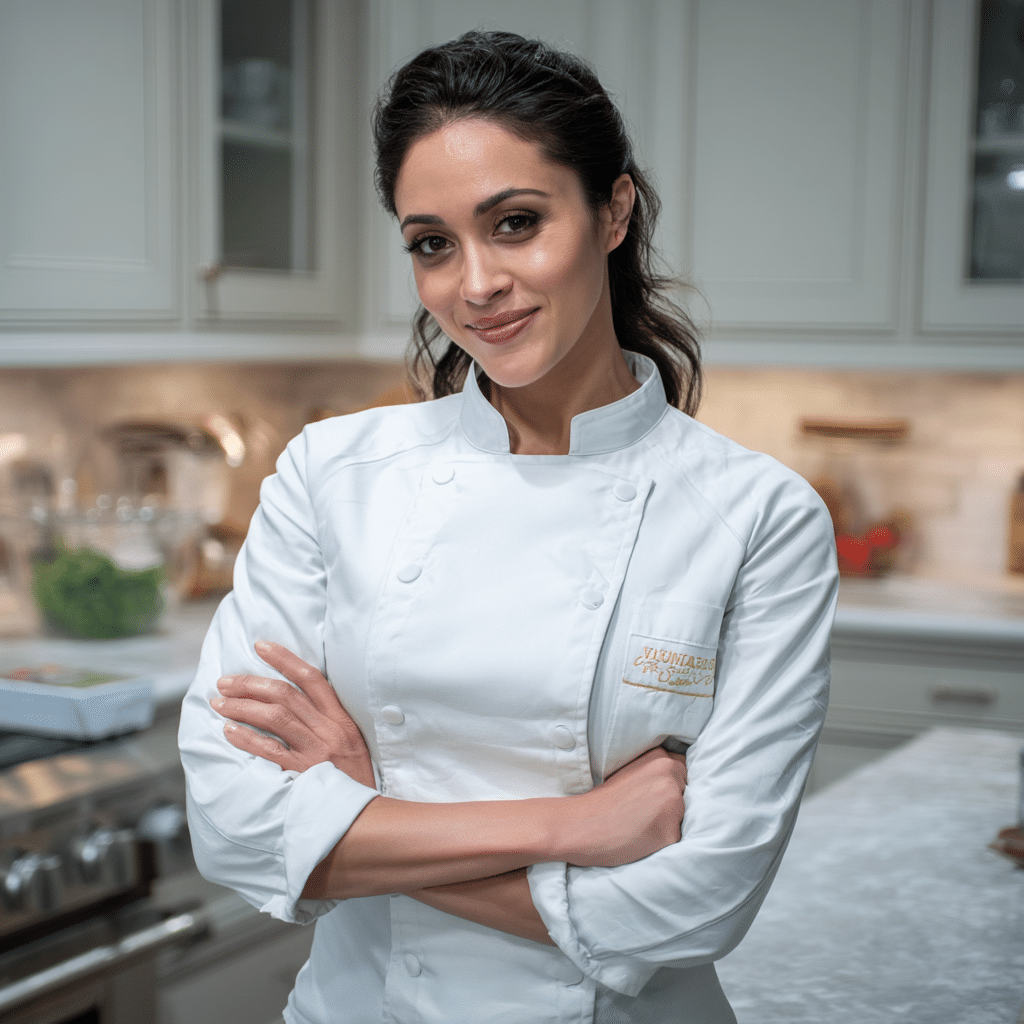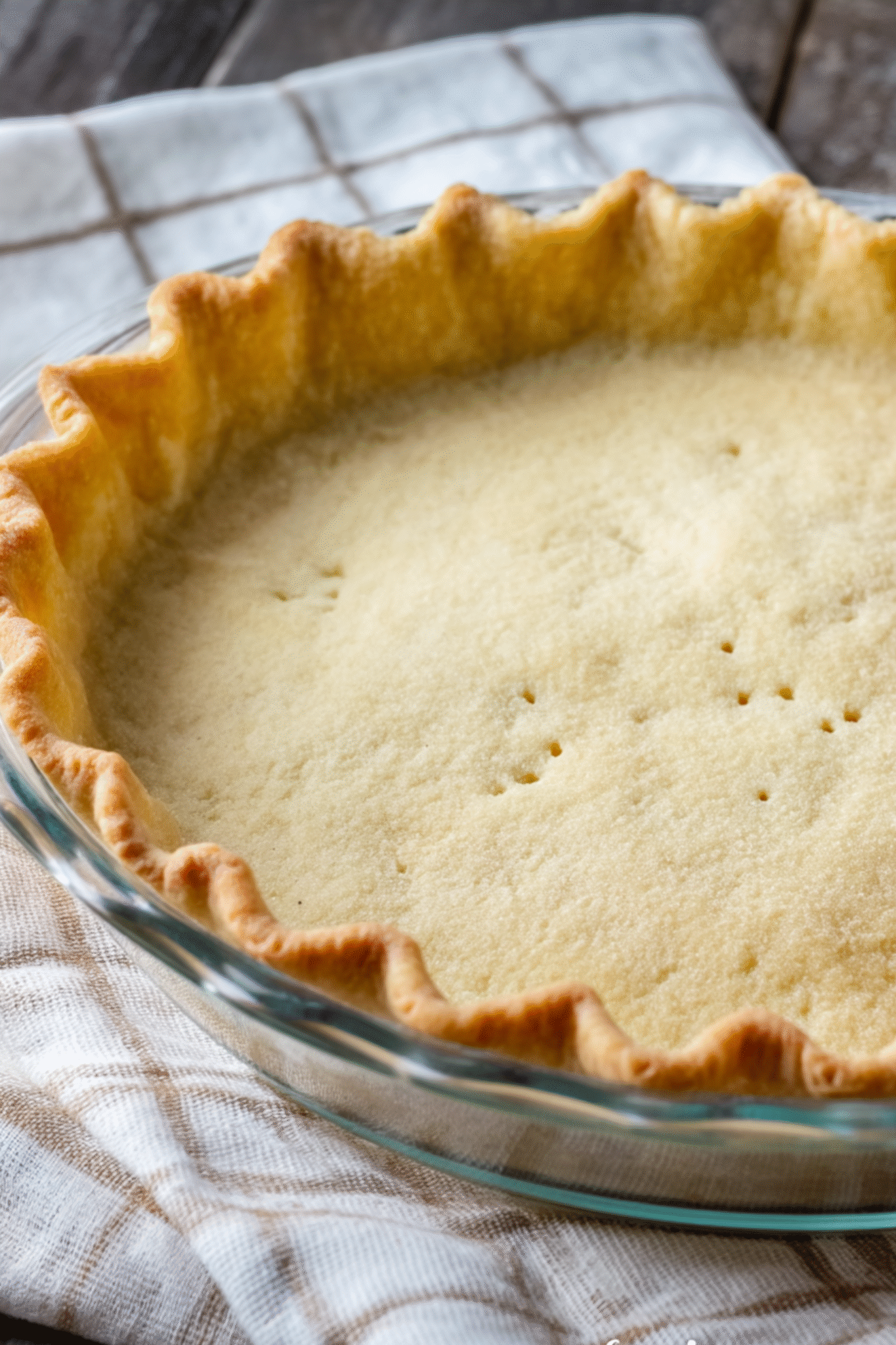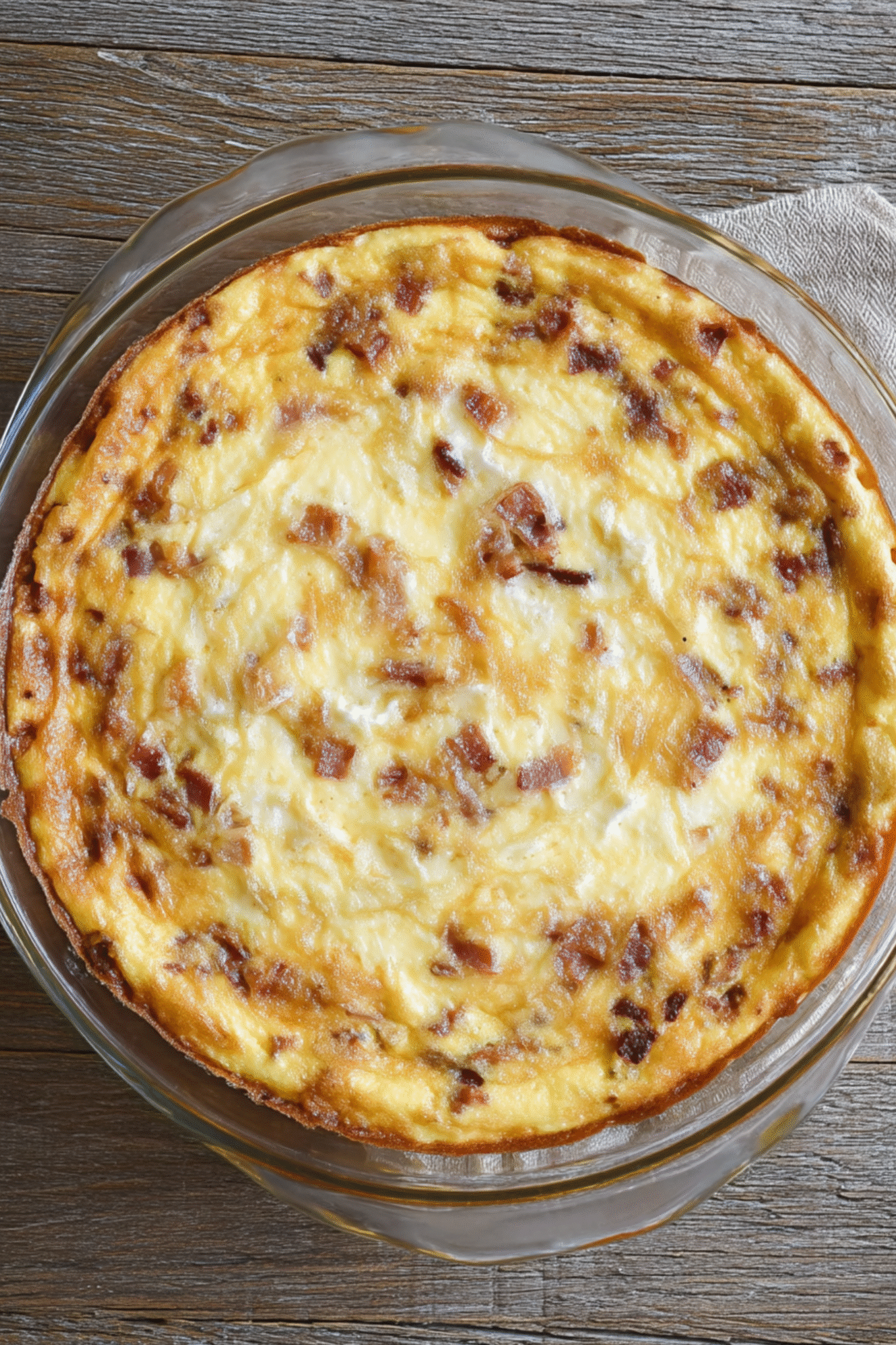Cote de boeuf rib steak is one of those cuts that turns a simple meal into something memorable. In this guide, I’ll show you exactly how to cook cote de boeuf rib steak to perfection, whether you’re hosting a dinner party or treating yourself. We’ll walk through what makes cote de boeuf rib steak unique, how it compares to ribeye, the best cooking methods, and its American equivalent. From selecting the right cut to pan-searing and butter-basting with herbs, this cote de boeuf rib steak recipe will leave you confident, hungry, and ready to impress.
Table of Contents
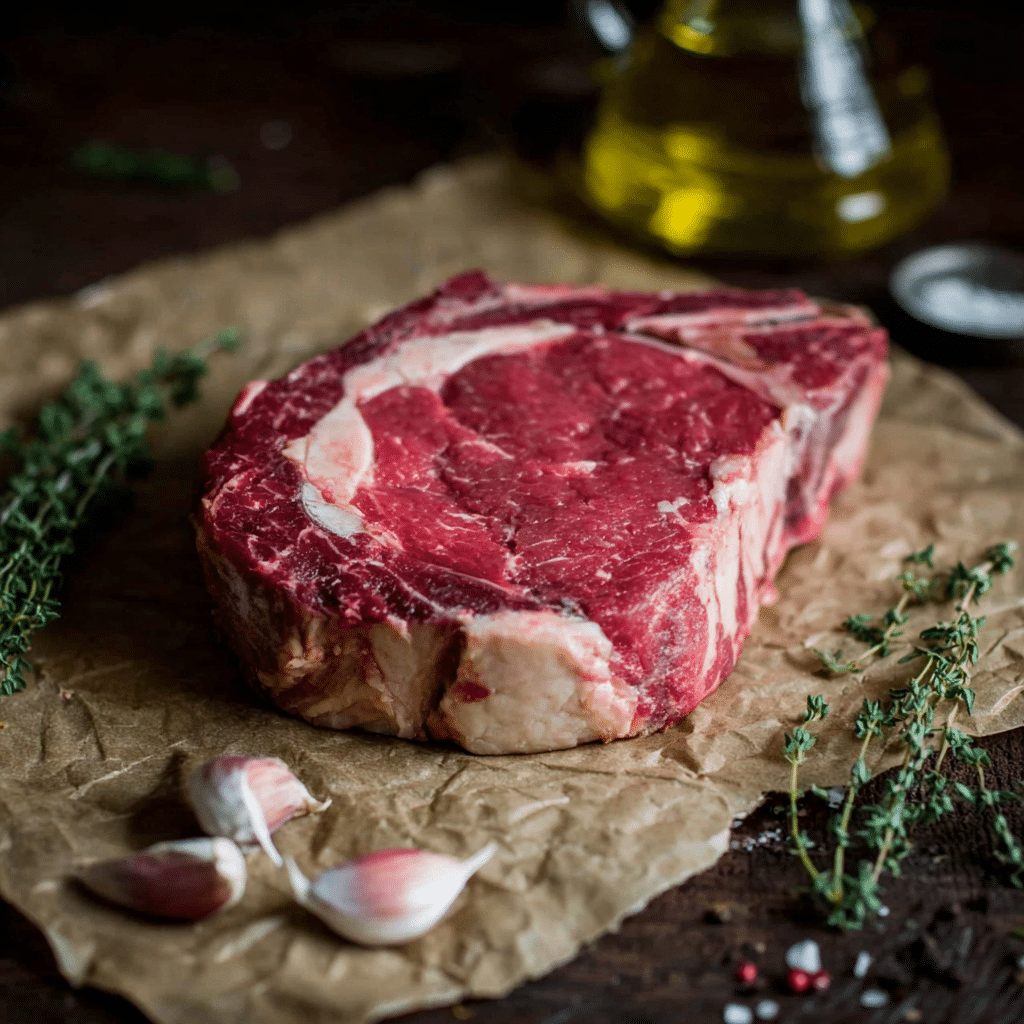
From Naples to New York — My Love for Cote de Boeuf Rib Steak
A Family Tradition, Reimagined in NYC
Growing up in Naples, Italy, beef was a celebration food—something my mom would prepare only for special Sundays. She’d take her time with it, seasoning simply and cooking with an intuitive touch that only a mother could master. While we didn’t call it “cote de boeuf,” the spirit was the same: a big, bone-in rib steak that fed everyone and brought the room to life.
Fast-forward to my kitchen in New York City. I still crave that same experience. The smell of beef hitting a hot pan, garlic sizzling in butter, thyme crackling under heat—it brings me right back. That’s why cote de boeuf rib steak has earned a permanent place in my kitchen. It’s rustic, elegant, and deeply satisfying. My mother called it having “a delicious hand”—cooking with heart, not rules.
When I serve this, whether it’s for two or ten, it never fails to impress. And the best part? It’s so much easier than people think.
What Makes Cote de Boeuf Special?
So what exactly is cote de boeuf rib steak? It’s a French cut—literally “rib of beef”—from the rib primal. It’s similar to a ribeye but cut thicker, with the bone left in. A cote de boeuf rib steak typically weighs between 800g to 1.2kg and is made to be shared.
Unlike thin ribeye steaks, the cote de boeuf rib steak is substantial. It demands a slower cook and rewards you with deep beefy flavor, gorgeous marbling, and a jaw-dropping presentation. It’s a showstopper you can cook in your own home with just a few ingredients and a cast iron skillet.
While you’ll find it in fine French brasseries, I think the best cote de boeuf rib steak is the one cooked with care, basted with butter, and served with intention at home.
Choosing and Prepping the Best Cote de Boeuf Rib Steak
How to Buy the Right Cut: Bone-In Ribeye vs. Cote de Boeuf
One of the most common questions I get is: Is cote de boeuf the same as ribeye? The short answer is—almost. Both are cut from the rib primal, but there are key differences. A standard ribeye is often boneless and sliced thinner. In contrast, cote de boeuf is a bone-in, thick-cut steak, often weighing 800g to over 1kg, and designed for sharing.
When shopping, ask your butcher for a bone-in prime rib steak or “tomahawk without the long bone.” You want a steak at least 2 inches thick, ideally dry-aged or with excellent marbling. Don’t be shy—mention “cote de boeuf” by name, or reference a French-style rib steak to get the exact cut.
Look for these hallmarks:
- Generous marbling (those thin streaks of white fat)
- A short rib bone attached
- A thick slab, not a thin steak
- Rich red color with creamy, firm fat
Trust me, your effort in sourcing a proper cut is worth it. Quality meat is 90% of this recipe.
If you’re wondering where this sits in French butchery terms, cote de boeuf is technically cut from ribs 6–12, the same section used in American prime rib roasts. So yes, Americans call cote de boeuf simply a bone-in ribeye or a prime rib steak when cut thick.
This is the same philosophy I apply to selecting proteins in my main dishes category: go for whole ingredients with flavor and structure.
Why Marbling, Thickness, and Bone Matter
Marbling isn’t just for looks—it’s essential for taste and texture. Those fat streaks melt during cooking, self-basting the meat and making each bite incredibly juicy. That’s why this cut doesn’t need a marinade or complex prep. It’s a celebration of the meat itself.
The thickness is just as important. A thicker steak sears beautifully on the outside while staying medium-rare inside. It also holds up better in a two-stage cook—pan then oven—which is the traditional French approach for this dish.
And the bone? Besides looking dramatic and impressive on a platter, the bone adds flavor, conducts heat, and helps retain moisture. It’s part of the charm and tradition of cote de boeuf. When I prepare this cut, I always remember what my mother said: Let the ingredients speak first—then you finish the conversation in the pan.
Before cooking, let the meat sit at room temperature for at least 45 minutes. Pat it dry, season generously with salt and cracked pepper, and rub lightly with oil. That’s it. No sauces, no tricks—just preparation with purpose.
Print
Cote de Boeuf Rib Steak Recipe
- Total Time: 1 hr
- Yield: 2 servings 1x
- Diet: Gluten Free
Description
Juicy, bone-in French-style ribeye steak seared and butter-basted with garlic and herbs. A celebration dish that’s surprisingly simple.
Ingredients
800 g beef ribeye on the bone (prime rib bone-in)
1 tablespoon avocado oil or olive oil
Salt flakes and cracked black pepper
2 cloves garlic
3 sprigs fresh thyme or tarragon
2 tablespoons butter
Instructions
1. Bring the steak to room temperature for 45 minutes.
2. Preheat oven to 400°F (200°C).
3. Pat steak dry and season generously with salt and pepper.
4. Heat a cast iron pan over high heat until smoking.
5. Sear steak for 2 minutes per side, including edges.
6. Add butter, garlic, and herbs to the pan.
7. Tilt pan and baste steak with melted butter.
8. Transfer skillet to oven and roast for 8–10 minutes for medium-rare.
9. Remove and let rest for 10 minutes under foil.
10. Slice meat from bone and carve into thick slices.
Notes
Use a meat thermometer for accuracy—125°F for medium-rare.
You can substitute rosemary for thyme or tarragon if preferred.
Serve with roasted potatoes and a green salad.
- Prep Time: 45 min
- Cook Time: 15 min
- Category: Main Dishes
- Method: Pan-Sear + Oven Roast
- Cuisine: French
Nutrition
- Serving Size: 400g
- Calories: 850
- Sugar: 0g
- Sodium: 720mg
- Fat: 62g
- Saturated Fat: 24g
- Unsaturated Fat: 36g
- Trans Fat: 0g
- Carbohydrates: 1g
- Fiber: 0g
- Protein: 72g
- Cholesterol: 220mg
Keywords: cote de boeuf rib steak, bone-in ribeye, French steak recipe
How to Cook Cote de Boeuf Rib Steak Perfectly Every Time
Pan-Sear, Oven-Finish: The Foolproof French-American Way
The beauty of cote de boeuf rib steak lies in its simplicity. You don’t need fancy gear—just a heavy cast iron skillet, an oven, and a good sense of timing. This two-stage technique—searing then roasting—gives you that gorgeous golden crust with a tender, medium-rare interior.
Here’s my go-to method, perfected over years of cooking in small NYC kitchens:
- Preheat your oven to 400°F (200°C).
- Pat dry your steak with paper towels—this ensures a crisp sear.
- Rub the steak lightly with avocado oil or olive oil. Season generously with salt flakes and cracked black pepper on all sides.
- Heat your cast iron pan over high heat until smoking hot.
- Sear the steak for about 2 minutes per side, including the edges. Don’t move it around—let the crust form.
- Add 2 crushed garlic cloves, fresh thyme or tarragon, and 2 tablespoons of butter to the pan.
- Tilt the pan and baste the steak with the melted butter, using a spoon. Let those herbs and garlic infuse the fat.
- Transfer the skillet to the oven. Roast for 8–10 minutes for medium-rare (internal temp: 125°F / 52°C), or longer if you prefer medium.
- Use a meat thermometer for accuracy—this steak deserves precision.
Cooking cote de boeuf is about trusting the process. You’re building flavor at each step, from the high-heat sear to the gentle oven finish. The pan juices, garlic, and thyme mingle into something unforgettable.
I use the same timing logic when developing recipes for other mains like reverse-seared pork tenderloin or garlic herb chicken thighs on my All Recipes page—high heat to seal, slow heat to perfect.
Resting and Carving: Don’t Skip These Crucial Final Steps
Once the steak is out of the oven, resist the urge to cut in. Rest it for at least 10 minutes on a cutting board, loosely tented with foil. This step lets the juices redistribute, giving you tender, juicy slices instead of a puddle on the board.
Now for the fun part: carving.
- Place the steak bone-side up.
- Slice along the bone to remove it cleanly.
- Cut the meat across the grain into thick slices—about ½ inch thick.
Drizzle with those gorgeous pan juices and serve immediately. The exterior should be deep brown and crisp, the inside juicy and rose-pink. Serve on a wooden board or warm platter, family-style.
I always say: The moment of slicing is when a meal becomes a memory. Add a side of mustard or compound butter, and you’ve just created your own brasserie experience at home.
Serving Ideas and Flavor Pairings
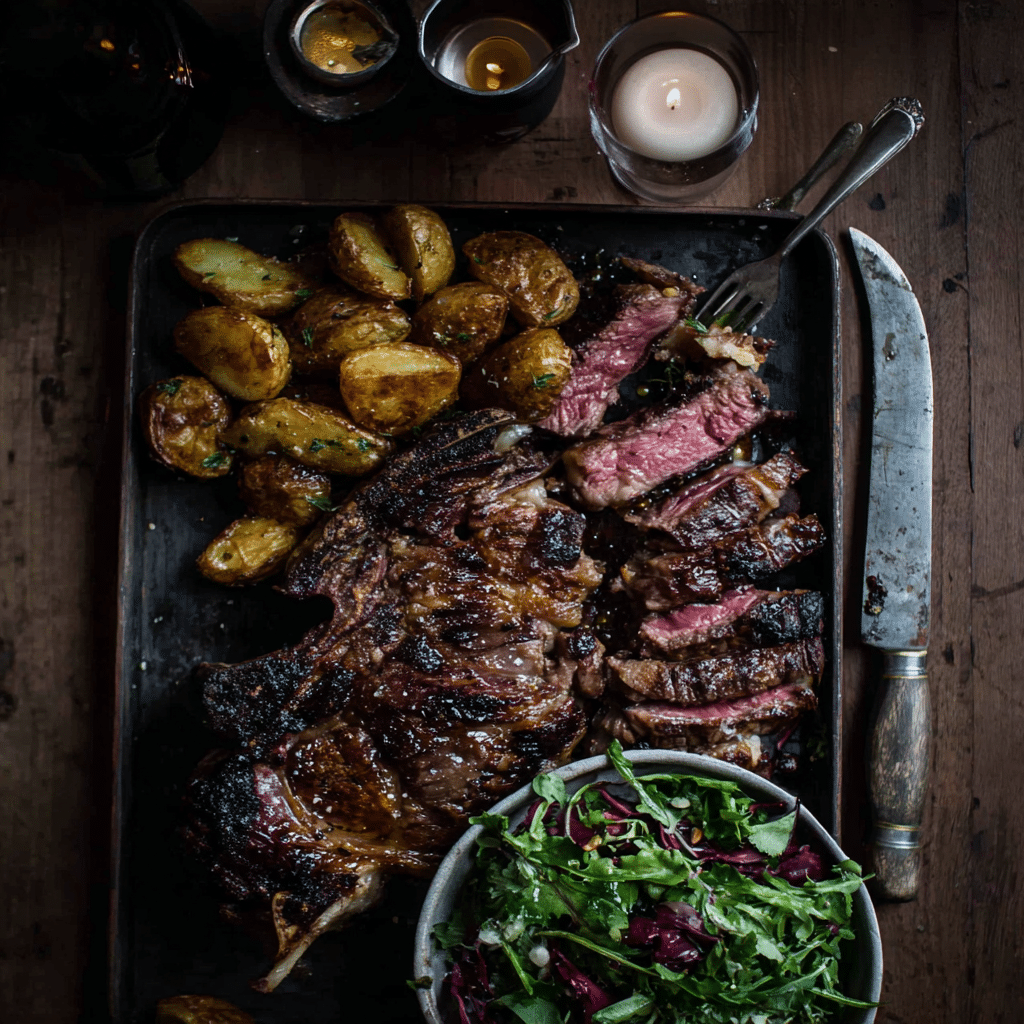
Classic French Butter & Herb Baste
The beauty of cote de boeuf rib steak is that it doesn’t need much to shine—but the finishing touch makes all the difference. That final butter and herb baste in the pan? That’s the secret to French steakhouse magic.
After searing and before placing the steak in the oven, I add:
- 2 tablespoons of butter
- 2 smashed garlic cloves
- 3 sprigs of thyme or tarragon
As the butter melts and browns slightly, it pulls out the aromatics from the herbs and garlic. I tilt the pan and spoon that fragrant butter over the meat again and again. This creates a glistening crust and builds layers of flavor that no seasoning rub could replicate.
If you’re feeling extra, you can swirl in a small spoon of Dijon mustard or anchovy paste at the very end of basting—just enough to deepen the umami. This step also works wonders in my main dishes approach, where I focus on big flavor through minimal fuss.
Once the cote de boeuf rib steak is sliced, I pour the remaining pan juices right over the steak or offer them on the side for dipping. It’s simple, but feels indulgent.
What to Serve with Cote de Boeuf Rib Steak
The richness of a cote de boeuf rib steak calls for bold but clean sides. Here are my favorite pairings:
Crispy Fingerling Potatoes
Roasted in the oven with rosemary and sea salt. You want crispy edges and a soft interior—perfect for soaking up steak juices.
French Bistro Green Salad
Think peppery arugula, shaved fennel, and a bright lemon-Dijon vinaigrette. It cuts the richness of the meat and freshens the plate.
Steakhouse Mushrooms
Sautéed cremini or shiitake with garlic and butter—earthy, savory, and deeply satisfying.
Simple Sauces (Optional)
- Béarnaise if you want to go full French
- Chimichurri for a fresh herb punch
- Or just serve it with a little Maldon salt and extra black pepper
For an elegant touch, I sometimes garnish the platter with roasted shallots or a drizzle of reduced balsamic. But more often than not, the steak is the star—and everything else steps aside.
And there it is: a meal that feels luxurious but is 100% doable in a home kitchen. Cooking cote de boeuf rib steak isn’t just about feeding people—it’s about slowing down, plating with intention, and celebrating flavor in its purest form.
Frequently Asked Questions about Cote de Boeuf Rib Steak
Is a cote de boeuf the same as a ribeye?
Not exactly. A cote de boeuf rib steak is a bone-in, thicker version of the ribeye cut, often prepared and presented differently.
How should cote de boeuf be cooked?
The best method is pan-searing and finishing in the oven, followed by a rest period and carving. Butter-basting with garlic and herbs is classic.
What cut of meat is a cote de boeuf?
It’s a bone-in rib steak cut from the fore rib of beef. It typically weighs 800g–1.2kg and is known for its marbling and flavor.
What do Americans call cote de boeuf?
Americans refer to it as bone-in ribeye steak or prime rib steak. When cut large, it’s similar to a tomahawk steak without the extended bone.
Conclusion
There’s something incredibly rewarding about making cote de boeuf rib steak. It’s not about fuss or flair—it’s about choosing great ingredients, cooking with care, and enjoying the ritual. Whether you’re channeling a cozy French brasserie or your own family traditions like I do, this dish encourages you to slow down and savor every moment. I hope you make it, make it yours, and start your own ritual around it. From my kitchen in NYC to yours—bon appétit.
If you enjoy recipes like this, follow me on Pinterest for more cozy, flavor-packed dishes, and join me on Facebook to keep the conversation going—I’d love to connect with you there!

